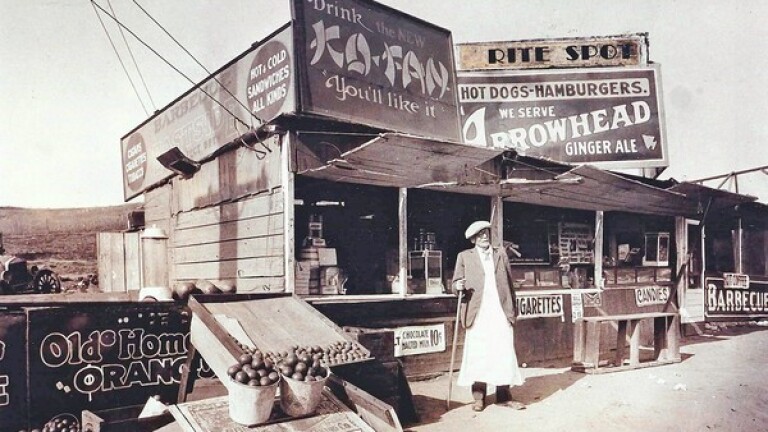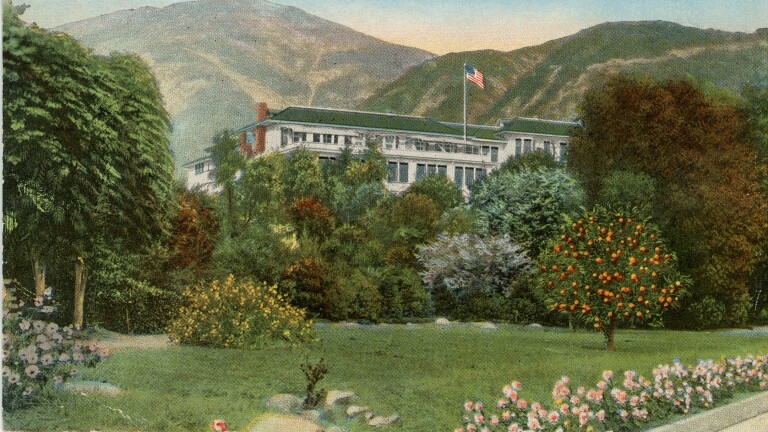Summer Skiing and Southern California's Switzer-land

As spring warms into summer, many Southern Californians are returning to the local mountains to enjoy the fresh air, tranquil settings, and opportunities for physical exercise. In doing so, they join a long tradition of hiking, camping, fishing, and other recreational activities in our region's mountain ranges.

Regional boosters exploited the mountains' abundant opportunities for recreation, extolling—as some Angeleños still do today—the ability to play in the surf in the morning and on sylvan hillsides in the afternoon.
In the late nineteenth century, many who responded to the boosters' appeals settled near the base of the San Gabriel Mountains in Pasadena. In 1884, one such man, a health seeker named Commodore Perry Switzer, opened a fifteen mile trail up the Arroyo Seco to a pristine mountain playground of crystal pools and deep gorges. Switzer built a camp near a seventy-foot waterfall. The settlement became famous as "Switzer-land", and, as Charles Frederick Holder wrote in All about Pasadena and Its Vicinity (1889), was "visited by nearly every person who tarries in Southern California."
Switzer's camp could be reached only by a twice-weekly burro train or by foot; exhausted hikers were instructed to ring a cowbell a half-mile below the resort to signal how many hungry visitors the camp should expect.
In 1911, ownership of the mountain resort changed hands, and the new proprietor, Lloyd Austin, added luxury amenities such as tennis courts. Austin also built an impressive chapel, perched on a rocky outcropping, views of Switzer falls below. In its peak years, Switer-land counted movie stars such as Shirley Temple and Clark Gable among its guests.


To the east, wooded glens and the cool spray of another towering waterfall spawned another mountain resort community in Big Santa Anita Canyon. In 1896, Wilbur M. Sturtevant blazed a trail to the head of the canyon and established a trail camp there. Downstream, a village of cabins huddled near the waterfall - eventually named for Sturtevant. Among the cabins was Muir Lodge, which served Sierra Club members from 1913 until a flood washed away the structure in 1938.

Pioneers like Switzer and Sturtevant helped usher in Southern California's so called golden age of hiking, when families spent their vacations traversing the local mountains on foot, camping trailside under tents or in improved camps. The resorts, most linked to each other and with the city below by only foot trails, thrived amid the public's fascination with the wilderness next door.
To capitalize on Southern Californians' thirst for the outdoors, Thaddeus Lowe, a Union aeronaut during the Civil War, built a narrow-gauge railway from Altadena to the crest of the San Gabriels. The engineering marvel, which included a three-railed funicular, deposited passengers nearly 5,000 feet above sea level at the Alpine Tavern. From there, visitors could explore the surrounding wilderness—or play tennis under the pine trees, if they wished.

In the 1930s and 40s, Southern California's enthusiasm for the wilderness resorts of the San Gabriels ebbed as construction of the Angeles Crest Highway advanced across the mountain range. Switzer's Camp struggled through the 1950s and was forced to close in 1959, despite its location alongside the highway. Today, all that remains of Switzer-land—as well as the Alpine Tavern and the Mount Lowe Railway, abandoned in the 1930s—are trailside ruins. (Modern Hiker offers an excellent trail guide for exploring the old route of the Mount Lowe Railway.)


Toward the east end of the San Gabriel Mountains, the Mount Baldy area has long been a base of operations for summer recreation—nearby Icehouse Canyon once boasted a large cabin community—but it is perhaps better known as a wintertime destination for local skiers. In the 1950s, the Mount Baldy Ski Resort tried to boost summertime business by introducing novel forms of outdoor recreation. Jane Leffler, whose husband co-founded the resort in 1948, explained in this oral history, archived at the Center for Oral and Public History at California State University Fullerton:
[Summer skiing], that's skiing on the straw. We have a rope-tow, and a lot of kids learned how to ski on the straw. That was so funny that couple of weeks ago, there was a man at church—and, I don't know who he was, they were new—and, we got talking after church. I don't know how the subject of ski lifts came up—or, somebody introduced me and said, "[She and] her husband used to run a ski lift." He said, "I remember coming up to Baldy when I was thirteen and learning how to ski on the straw." See, this is how many years ago? He was fifty-eight or something now. (laughs) [For the summer ski jumping] we've got these two jumps. We have a thirty-meter and a ninety-meter...We went all the way down to Indio and got cotton sheet rolls. I don't know what they—who decided that would work. Al Franken, who was a—and, his son still works at Alta, Utah--he was a jumper, a Norwegian jumper. He'd come over in the summer and teach jumping on this, and they jumped on the cotton sheet holes.
The Santa Monica Mountains have also long been a favorite year-round destination for Southern Californians hikers, campers, and nature lovers. Following a sustained campaign by local conservationists to win protected status for the mountains, the federal government created the Santa Monica Mountains National Recreation Area in 1978.
Administered by the National Park Service, the sprawling national recreation area (a member institution of L.A. as Subject) encompasses a growing patchwork of federal parkland, several state parks, and a host of local parks and other conservation areas.

One of the lesser-visited federal park areas within the national recreation area, Peter Strauss Ranch was once the site of the Lake Enchanto mountain resort. The resort, pictured above, was known as Lake Shoson when it opened in the 1930s. It welcomed visitors to the "natural paradise" of the Santa Monica Mountains—complete with a 650,000 gallon swimming pool—until the complex closed in the 1960s.

Many of the archives who contributed the above images are members of L.A. as Subject, an association of more than 230 libraries, museums, official archives, personal collections, and other institutions. Hosted by the USC Libraries, L.A. as Subject is dedicated to preserving and telling the sometimes-hidden stories and histories of the Los Angeles region. Our posts here will provide a view into the archives of individuals and cultural institutions whose collections inform the great narrative—in all its complex facets—of Southern California.


